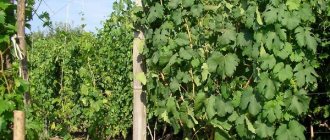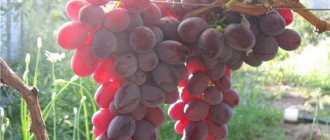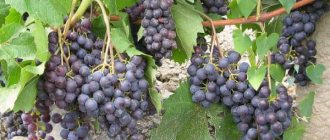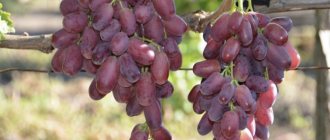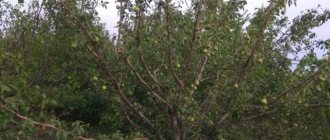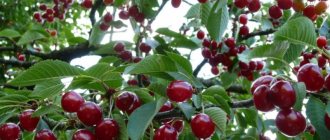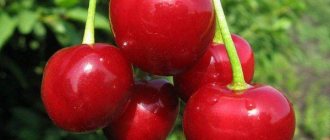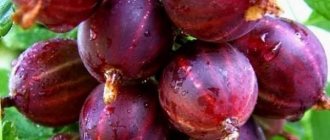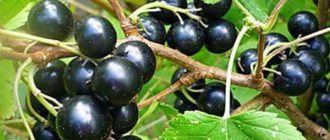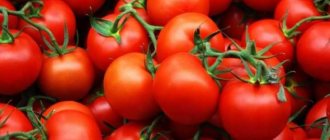Advantages and disadvantages
Thanks to a number of positive characteristics, Charlie is one of the most popular early ripening grape varieties. However, it has not only advantages, but also some disadvantages.
Main advantages of the variety:
- Stable and high yield.
- Easy to care for.
- Good commercial quality and transportability.
- Possibility of cultivation both on personal plots and on industrial plantations.
- Resistance to humidity, frost, diseases and pests.
Also, the fruits of the Charlie variety are characterized by uniform ripening on the bunch and are not prone to peas.
The Charlie variety has virtually no disadvantages. The only minor disadvantages include the need to form young shoots and the tart “nightshade” taste of the berries, which not everyone likes.
Advantages and disadvantages
Charlie forms large clusters, abundantly strewn with berries
In many respects, Charlie grapes occupy a leading position among medium-ripening varieties. Summarizing its advantages, the list of main indicators includes the following:
- high stable yield with minimal care;
- uniform ripening of bunches;
- beautiful presentation along with excellent transportability of berries;
- suitable for planting both in small areas and for huge industrial plantations;
- high resistance to diseases and insect damage;
- absence of peas (formation of small grapes);
- resistance to frosty winters, high humidity and spring frosts.
There are practically no shortcomings in the variety. All that can be distinguished is a peculiar tart taste with the aroma of nightshade. However, this phenomenon disappears when the berries are fully ripe.
Origin
Charlie grapes are the result of breeding work by the famous winegrower E. G. Pavlovsky. It was he who crossed the known and bred in the middle of the 20th century. the "Victoria" variety, which has high agrotechnical indicators, with the "Nadezhda AZOS" variety, which gained popularity due to its excellent taste and resistance to disease and frost, and received a new hybrid form of grapes.
“Charlie’s” parents are “Victoria” and “Nadezhda AZOS”
The variety was on a trial period for more than 10 years and was included in the State Register of Agricultural Crops in 2015 under the name “anthracite”. The patent holder is Kuban State Agrarian University named after. Trubilina.
Adviсe
Tip 1
Not everyone likes the taste of Charlie grapes and is often disappointed with it. Therefore, when deciding on its cultivation, you need to carefully consider its further use. Many gardeners in the middle zone use it to make wine.
Tip 2
To help the vine ripen, you need not to overload the bush with the harvest, keep it in a healthy state: fight diseases and pests in a timely manner. Removing old leaves from the bottom of the shoot after the harvest has a positive effect on ripening.
Main characteristics
“Charlie” or “anthracite” is a table grape variety, popular among beginners and professional gardeners and winegrowers due to its unpretentiousness and high yield.
Maturation period and class
“Charlie” is an early ripening variety - the harvest can be harvested in the 1st decade of August , i.e. the growing season lasts 105-115 days.
Bush
The bushes are medium-sized, characterized by a high ability of shoot formation - already on five-year-old bushes there can be 30-40 shoots.
The leaf blades are reticulate-wrinkled, of medium size, five-lobed with an average degree of dissection, have slight pubescence, and are painted a rich bright green color.
During flowering, bisexual flowers are formed, which indicates that there is no need for forced pollination of the bushes.
Bunches and berries
The clusters are medium-dense or even loose, most often conical in shape, large - their length reaches 35-40 cm , and the average weight is 700-900 g, although there are specimens weighing 1.5-2 kg.
The berries are large, egg-shaped, weigh about 5-9 g, covered with a dense skin of a rich dark blue color, which is practically not felt when eaten.
The pulp is fleshy and dense, the juice is clear, inside each berry there are 2-3 medium-sized seeds. The sugar content of the fruit is 18-22%, acidity is 4-7 g/l.
Taste
The taste is pleasant, balanced, there is a slight tart aftertaste of nightshade, about which winegrowers disagree. Thus, some believe that nightshade in the taste of Charlie berries indicates insufficient ripeness of the fruit, others argue that it is felt only in fruits taken from bushes under 5 years old, others are of the opinion that the taste of grapes depends on the growing conditions of the variety and soil composition.
Productivity
From one adult bush you can get 15-20 kg of berries, and these are far from record figures. On average, the yield of 1 hectare of land is about 138.8 centners.
Reference! Already 2 years after planting, 3-4 clusters weighing about 1 kg can fully ripen on the bushes.
Requirements for the site and soil
A correctly selected site is the key to good bush growth and, ultimately, high yield.
For the formation of ovaries and ripening of berries, illumination plays an important role, so the site should be in a sunny place and not in a draft. The best option is a place near a fence or building, facing south. In areas with a slope, you should choose a southern or southwestern slope with a south-north direction.
If it is not possible to plant grapes near the building, you can specially build a fence (east-west direction), 1.8-2 m high - it will create conditions for good lighting and protect from winds.
The following fact should also be taken into account - after previous plantings of grapes, vines can only be planted in this place after 3 years.
The variety has no special preferences for soil, but it is important that there is no stagnation of water in the area - the groundwater level is not higher than 1.5 m. If they are located higher, the roots do not have enough oxygen.
It is undesirable to plant crops nearby that require more moisture than grapes.
Features of cultivation
Despite the fact that “Charlie” is a fairly unpretentious grape variety, it is important to follow the rules of agricultural technology and the necessary conditions for planting bushes. The quality of the harvest and its quantity depend on this.
Landing
Grapes can be planted on the site in the fall (late October-early November) or spring (late April-early May), before or after the sap flow process. The most suitable option is spring planting; in this case, the bushes have the opportunity to take root well and stock up on nutrients during the summer.
This grape variety loves the sun, so the bushes should be planted on the south side of the site , far enough from other, especially tall, plants that will shade them.
It is important to avoid places prone to waterlogging and ensure that the groundwater level is at least 1.5 m, otherwise the root system may die from lack of oxygen or rot.
“Charlie” does not have any special requirements regarding the composition of the soil, but prefers black soil and loam. The bushes also grow well on sandstones and in carbonate, rocky or weakly carbonate soil.
Reference! Charlie bushes take root and grow even in the shade, but in this case the yield of the variety is reduced.
Watering and fertilizing
Charlie grapes need moderate watering from the end of April to the second half of October:
- After the first cut.
- When the shoots reach a height of 30 cm.
- Before bud formation.
- After flowering.
- During fruit ripening.
- After the harvest.
Water should be added into grooves made along the diameter of the planting hole, the depth of which is 20 cm, or immediately under the base of the bush, 10-15 liters per bush.
It is also necessary to regularly feed the bushes, as they quickly absorb nutrients from the soil.
Fertilizer application schedule:
- The first ten days of April - 10 kg of cow manure and 5 kg of bird droppings, diluted in 40 liters of water and infused for 7 days (10 liters / bush).
- During the formation of ovaries and after flowering - 10 g of ammonium nitrate per 1 sq. m.
- During fruit ripening - 30 g of superphosphate, 20 g of nitrophoska, 50 g of ash, diluted in 10 liters of water (5 liters/bush).
- After harvesting - cow manure (5-7 kg/bush).
Feeding is applied to grooves 35 cm deep, made 45-50 cm from the base of the bush.
Trimming
Regular pruning of bushes is carried out to thin them, which contributes to the formation of larger clusters and a bountiful harvest.
Charlie grapes need to be trimmed 3 times a year:
- In the spring, before the start of sap flow, when the average daily temperature is fixed at at least +5 °C, remove weak and frozen shoots in winter.
- In summer - sanitary pruning, which consists in removing stepsons.
- In autumn, at the end of October-beginning of November, before frost.
The first pruning involves shortening the shoots at the level of 1-2 buds so that no more than 30 buds are formed on the bush, the second - at the level of 6 buds to preserve frost-resistant layering, the third - above 12 buds to form a strong and healthy bush.
Diseases and pests
The Charlie variety has a sufficient degree of resistance to powdery and downy mildew and fungal diseases.
These grapes are practically not affected by pests; the greatest danger to the fruit is birds and wasps.
At the same time, you still need to regularly spray the bushes with insecticides and antifungal agents in order to prevent the development of diseases and pest attacks.
Frost resistance
Charlie bushes can withstand frosts down to -24-25 °C and, when grown in the southern regions, are able to winter without shelter. In other areas, due to the likelihood of even greater frosts, bushes should still be covered.
Important! This grape variety recovers well after spring frosts, as well as heavy rains and hail.
Harvest storage
After harvesting, the brushes should be placed in wooden boxes and taken to a basement , cellar or other dark and cool room with moderate humidity. In such conditions, the berries are stored for several months.
Regions
Due to a fairly high degree of frost resistance, the ability to adapt to climatic conditions and quickly recover independently from bad weather, the Charlie grape variety is suitable for cultivation in all regions, even those characterized by short summers.
Charlie grapes: variety description
Charlie's grapes: photos
Charlie grapes are characterized by medium growth vigor against the background of early ripening of shoots. Winegrowers state the fact that even in central Russia this variety is capable of ripening at the beginning of the last summer month. In this regard, it is recommended to grow it in more northern latitudes, where summers are short. In addition, mature vines tolerate winter cold much better.
The variety bears fruit simply perfectly (up to 95%): the branches can withstand heavy clusters, and up to 7 ovaries are formed on one branch. True, in order for ripening to be complete, it is recommended to remove excess inflorescences so that one shoot has no more than two brushes. If you are greedy and leave more, then ripening will be greatly extended, and you may simply not wait for ripe berries - they will not be able to ripen.
Also pay attention to the size of the clusters: the larger the bunches, the less likely they are to ripen, especially in unfavorable summers. Conclusion: if the summer is sunny and warm, then leave a larger number of brushes on the branches (up to three pieces).
- First bonus: Charlie is great at sprouting. Even a young bush (up to 5 years old) can produce up to 40 shoots. The color of the leaves and shoots is deep green. The leaves are slightly dissected and slightly pubescent.
- Second bonus: the variety does not require pollination, since Charlie’s flowers are of both sexes. It turns out that if you plant one bush on your plot, you will definitely have a harvest!
- Third bonus: Charlie bushes are easy to propagate from cuttings, as it has an excellent ability to take root quickly. A growing season of 110 days (on average) is enough for the berry to gain sugar, taste and color. An average amount of sugar will be collected during this period. If you give the plant more time, you will get grapes with higher sugar content (up to 22%).
- The fourth bonus: the berries hang perfectly in clusters and do not fall out, and their size is basically the same. That is, if your grapes are for sale, then they do not need to be freed from small grapes, giving them a marketable appearance.
- Fifth bonus: the main advantage of the “Charlie” variety is a good, persistent harvest. A young bush can even produce up to 4 kg of berries in the second year. Mature bushes yield up to 20 kg each. And this is not a record!
- The sixth bonus: the frost resistance of the crop, which reaches -25 °C. Of course, no matter what, shelter for the winter is required, especially if these are northern regions, and the air temperature may be even lower.
- Seventh bonus: the variety quickly recovers from winter cold, spring frosts and even heavy rains with hail. The culture also copes well with various fungal diseases. Even if your plant is still susceptible to such a disease, preventive measures are often enough for it without the use of strong chemicals. It is important that this variety is not afraid of rot, even in the event of a rainy summer, unlike many other varieties that may not produce a harvest at all under such conditions.
This variety is very popular with wasps and various small birds. Therefore, it is better to protect ripening bunches from them using a special net.
Comparison with analogues
Let's compare “Charlie” with other varieties similar to it.
| Sign | Variety | ||||
| Charlie | Beauty of Nikopol | Fun | Julian | Rochefort | |
| Ripening period | 105-115 days | 105 days | 100-120 days | 100 | 110-120 days |
| Frost resistance | Up to -24-25 °C | Up to -22 °C | Up to -21 °C | Up to -23 °C | Up to -23 °C |
| Yield per bush | 15-20 kg | 25-30 kg | 25-30 kg | 30-60 kg | 4-10 kg |
| Bunches | 700-900 g | 400-600 g | 700-800 g | 800-1200 g | From 500 g to 1 kg |
| Taste | With a tart nightshade flavor | Sweet with nutmeg notes | Plum and cherry aroma | Notes of nutmeg and strawberry | Muscat aroma |
| Color | Dark blue | Dark pink | Dark blue | Light pink | Dark purple, almost black |
| Disease resistance | Average | Average | High | High | High |
| Shelf life | A few months | About 2 months | A few months | 1-2 months | 2 or more months |
| Sugar content | 18-22% | 18-20% | 19-22% | 28% | 14-18% |
| Acidity | 4-7 g/l | 5-6 g/l | 9 g/l | Not installed | 4-7 g/l |
Selection and preparation of planting material
A good strong seedling creates the preconditions for the growth of a strong and powerful vine. It is better to purchase it with a closed root system (in a container) in garden farms or nurseries, where there is information about the variety and growing conditions.
When examining a bush of a seedling, you need to pay attention to the height of the shoots (50-60cm) and the presence of 2-3 elastic roots.
Preparing planting material at home
The procedure for harvesting planting material consists of several stages.
Stage 1:
- in autumn, on a strong and developed vine, 8-10 mm thick and with internodes of 10 cm, remove leaves and shoots;
- cut cuttings from it 50-60 cm long with 3-4 eyes;
- moisten the cuttings in a pink solution of manganese, dry and place in water for 24 hours;
- Wrap the cuttings in film and put them in a cool place at t=0°- +2°C.
Stage 2 (late February-early March):
- immerse the cuttings in water for 48 hours;
- make cuts with a sharp tool above the upper eye by 2 cm and under the lower eye at a distance of 3-5 mm - this technique promotes rapid germination;
- after that, cut off the lower bud, and lower the upper one into molten paraffin (60°-70°C) and immediately into cold water (this technique protects against bacteria);
- on the bark, without touching the wood, make 4 cuts 3 cm long.
Stage 3 (kilching before root germination delays the opening of the eyes):
- tie the stalk in the lower part with a dampened cloth and wrap it in film;
- place the seedling on the windowsill with the top part facing the glass and the bottom part above the radiator;
- roots will appear after 2 weeks.
Information!
It is recommended to plant three weeks before frost (early to mid-October) or in the spring after the soil has warmed up.
Photo
Below, see photos and reviews of the “Charlie” variety.
Pest control and disease prevention
The resistance of Charlie grapes to mildew, powdery mildew, oidium, and gray rot is highly appreciated by gardeners. It is enough to follow standard agricultural practices and carry out preventive treatments with broad-spectrum insecticides and fungicides before flowering, immediately after flowering and after harvesting to ensure reliable protection of the vineyard.
Charlie is a grape for the table and more. It can often be seen on sale, since its good transportability and shelf life allow it to be sold fresh until the end of September.
Reviews
Charlie likes it for its increased resistance to disease. The harvest ripened this year on August 10. The taste contains tones of nightshade. Irina Ivanovna, Krasnodar region
Good for everyone, but the nightshade flavor lingers. Transportable, does not pea. Petr Nikolaevich, Pavlograd
The variety is unusually productive, with long clusters. Last season (the second year of life) I loaded it to the fullest, I thought it wouldn’t last, but it not only produced beautiful bunches, but also laid a wonderful harvest for this year. Boris, Ivano-Frankivsk
Rationing
An important stage in grape care is its rationing. Trimming a crop is not difficult, you only need to know the basics of this matter. It is best to carry out rationing in the autumn, when the leaves have fallen from the crop. In spring, only frozen shoots are removed, which will only create stress on the bush.
We recommend reading: “The Krasotka grape is an exquisite variety”
The most difficult procedure is crop rationing. You see how many bunches have formed, and they need to be trimmed. In general, if you leave more than 2 bunches on 1 shoot, then there is a high probability that the berries will pea or not ripen completely. So we cut it off. The rationing scheme is typical, as for any other variety. We leave 6-8 eyes on 1 shoot or 35 eyes on the entire bush.
The variety is winter-hardy, but still needs shelter (in particularly cold regions). If the region is moderately warm, then simply fold the vine and cover it with fallen leaves.
Rules for planting grapes
When planting rules are followed, Charlie grapes actively develop and produce high yields. Be sure to comply with work deadlines and choose a suitable location.
Recommended timing
The best time to plant grapes is the beginning of October, 3 weeks before the onset of cold weather. During this time, the seedling will take root and be able to overwinter. If early frosts are expected, work is left until spring. The grapes are buried in the plot, humus and sawdust are poured on top. The plant is planted in the spring, when the snow melts and the soil warms up. It is important to carry out the work before the leaves appear.
Choosing a suitable location
Grapes are picky about where they grow. A sunny place is selected for it on the south or west side of the site. To ensure that the vine receives more heat, it is placed next to a fence or building.
Attention! Grapes prefer fertile, loose soil.
Flat or elevated terrain is suitable for grapes. Landing in the middle of a small slope is allowed. The seedling is removed from apple, pear and other trees at least 5 m.
Selection and preparation of planting material
Charlie grape seedlings are purchased from a nursery or specialized center. The plant is inspected to detect mold, lichen, cracks and other defects. Before planting, the grapes are immersed in clean water for a day. An annual seedling is shortened, leaving 4 eyes. The roots of the plant are also trimmed.
Landing algorithm
The pit for Charlie grapes is prepared 3 weeks before the start of work. This period is necessary for soil shrinkage, which often leads to damage to the seedling. If planting is planned in the spring, the pit is prepared in the fall.
Charlie grape planting order:
- A pit with a diameter of 80 cm to a depth of 70 cm is dug on the site.
- A drainage layer 15 cm thick of expanded clay or crushed stone is poured onto the bottom.
- The pit is half filled with chernozem substrate, 180 g of superphosphate and 70 g of potassium salt. Then pour out a bucket of water and wait for the soil to shrink.
- Black soil is poured into the pit to create a low mound.
- Then the seedling is installed and its roots are straightened. Soil is poured on top.
- The soil is compacted and the grapes are watered.
Plant care
The most important year for your seedling is the first. It is at this moment that the foundation for its further prosperity is laid.
Immediately after planting, the grapes will:
- loosening the soil after each watering;
- watering as the tree trunk area dries out;
- pest prevention;
- bush formation;
- removing weeds as they appear.
In the summer, stepsons will appear that will need pruning. And in the fall you will need to remove fallen leaves, loosen the soil and cover the bush for the winter.
Important! It is not recommended to mulch the soil around the grapes. Its roots love sun and warmth, and mulch will keep them cool.
Garter bushes
During the summer, when the length of the shoot is 20 cm, a temporary support is installed. It can be a peg about 1 meter long, maybe a little longer.
If the trellis is vertical, then the garters are made in the same plane. Later, the fruit vines will be tied in several places to lighten the weight.
Autumn pruning
Always prune vines when they are dormant. Otherwise, they will “bleed” juice, losing energy. Typically, pruning is done at the end of winter, when there are no major frosts. In the fall, all secondary shoots and buds are cut off, leaving the main ones for fruiting the next year.
Did you know? Researchers believe that grapes appeared on earth 65 million years ago. And they began to cultivate it only 8,000 years ago.
Rules for watering and fertilizing
The first two or three years after planting, the grapes do not need to be fertilized, since the nutrients added during planting are sufficient for them. And then annually they fertilize with compost around the base of the bush. They do this in early spring.
A vigorous vine will use up the applied fertilizer over the summer. If you see from the condition of the vine that fertilizing is not needed and the vine is growing well, then you don’t need to apply fertilizer.
The first year the grapes are watered regularly - once a week. Moisten the measles area. Do not spray water on the leaves. Mature vines rarely need watering. They are watered according to the general watering of the garden.
Read more about how to properly water grapes.
Wintering grapes
You should start by warming the soil around the trunk:
You need to pile up as much soil as possible in a mound towards the base of the vine.
Remove the vines from the trellis and carefully bend them to the ground. Cover them with special covering material, straw, soil
The selected material should provide protection from frost and rodents. In the spring, before the buds swell, the vines are removed and tied back to the trellis.
Preventative treatments
In summer, grapes have to be protected from birds. To do this, use a net that is stretched over the vineyard.
The peculiarity of wasps and other insects that fly for sweets is that they do not bite through the thick skin of grapes, but work with “ready material”, that is, berries damaged by birds, so the first priority protection is protection from birds. Regularly remove any wood debris that may attract insects to the vines.
The good news is that insects rarely attack Charlie grapes. But it's still worth placing traps for them. Most pests hide in crevices and on the undersides of leaves. Traps will help you detect them in time and treat the grapes with an insecticide against those insects that are found. Treatments are carried out from June to August.
Did you know? The UN Food and Agriculture Department reports that the Earth's total vineyard area is 29,292 square meters. km. And most of them are in Spain, Italy, China and Turkey.
Basic disease prevention is the removal of dry leaves and berries, as well as timely pruning of the vine. Prevention of powdery mildew is carried out by ensuring a sufficient volume of air around the bush, so you should not thicken the plantings and save on the distance between the bushes.
If you are deciding which grape varieties to plant on your plot, then the Charlie variety will be one of the best. After all, climatic conditions, as well as types of pests, change. And new varieties are better adapted to them. They are a more advanced version of your old friends and are more viable.

